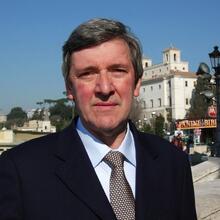Pope Francis’ condition remains “stable” and is slowly improving, the director of the Holy See Press Office, Matteo Bruni, told journalists in a briefing at the Vatican on April 1. He said this was confirmed by “the blood tests taken in recent days that registered normal values,” and “a chest X-ray that showed a slight improvement in the lung infection.”
“His voice has improved, thanks to the respiratory physiotherapy,” he added.
The pope’s doctors prescribed that the period of “rest and convalescence” should last “at least two months” when they discharged him from the hospital on March 23, after 38 days of treatment there for double pneumonia.
Pope Francis continues to undergo pharmacological, respiratory and physical therapies with some positive results. Blood tests are taken regularly during his protected convalescence, Mr. Bruni said.
The pope’s general mobility “is slowly returning to what it was before his hospitalization” on Feb. 14, he said. He walks “with assistance,” just as he did before his hospitalization. Since May 2022 he has used a wheelchair because of mobility problems caused by his right knee. “He dedicates significant time to physical therapy,” Mr. Bruni said.
Mr. Bruni said the pope also “gives some time to work, which he does at his desk.” He continues to govern the church and makes decisions regarding the nomination of bishops, appointments in the Vatican and canonizations. As the Vatican announced yesterday, Francis approved the canonization of the first saint from Papua New Guinea, Blessed Peter To Rot, a layman and catechist martyred for the faith in 1945. He also gave his assent to the canonization of the Armenian bishop Blessed Ignatius Choukrallah Maloyan, who was martyred by Turkish forces in 1915 for refusing to deny the faith.
The pope “continues to receive oxygen through the nasal tubes, high flow oxygen during the night and whenever needed,” Mr. Bruni said. For short periods of time, he does not use this oxygen and sometimes removes the nasal tubes when he is able to breathe for himself.
Pope Francis concelebrates Mass every morning in his private chapel near his apartment on the second floor of Santa Marta.
He is “in good humor” and “receives much affection” from people worldwide, Mr. Bruni said. Following his doctor’s advice, however, he has not received visitors—except his doctors—to avoid the risk of infections. The 88-year-old pope is not left alone in his apartment, however, as he is assisted by three private secretaries and two nurses who provide 24/7 medical care.
The Jesuit pope touched on the question of not being alone in a March 28 message to participants at the second assembly of the synod of the Italian church when he said: “Christian joy is a gift of God. It is not an easy joy, it does not come from comfortable solutions to problems, it does not avoid the cross, but flows from the certainty that the Lord never leaves us alone. I, too, have experienced this in hospitalization, and now in this time of convalescence.”
During his convalescence, he receives visits from Dr. Sergio Alfieri and other doctors from the medical team that treated him at the Gemelli Hospital. He also receives visits from the doctors of the Vatican’s health and hygiene unit. He has not received other visitors in this period.
Dr. Alfieri told the Associated Press that he met Pope Francis in the Vatican on March 26 and found him “in a much-improved condition. He is breathing better and speaking much better.” He used the Italian word “vispo” to describe the pope during their meeting, a word that in English means “sprightly” or “lively.” He said his voice was regaining strength and his reliance on oxygen was reduced.
As in recent weeks, the Vatican will release the written catechesis text for tomorrow’s Wednesday public audience. It also expects to release some photos of the pope in convalescence in the coming days.
The homily for next Sunday’s Jubilee Mass for the Sick will be prepared by the pope and read by Archbishop Rino Fisichella, the pro-prefect of the section for the New Evangelization at the Dicastery for Evangelization, whom he has delegated to celebrate the Mass.
The Vatican does not exclude the possibility that the pope might give the Angelus blessing in person next Sunday, perhaps from Santa Marta. His last appearance was at the balcony of Rome’s Gemelli Hospital at midday on Sunday, March 23.
Responding to questions, Mr. Bruni refused to make predictions regarding the pope’s participation in the Holy Week and Easter ceremonies. “It is premature for this,” he said. “We have to see how his condition evolves.”
The next Vatican briefing on the pope’s health will be on Friday, April 4.







